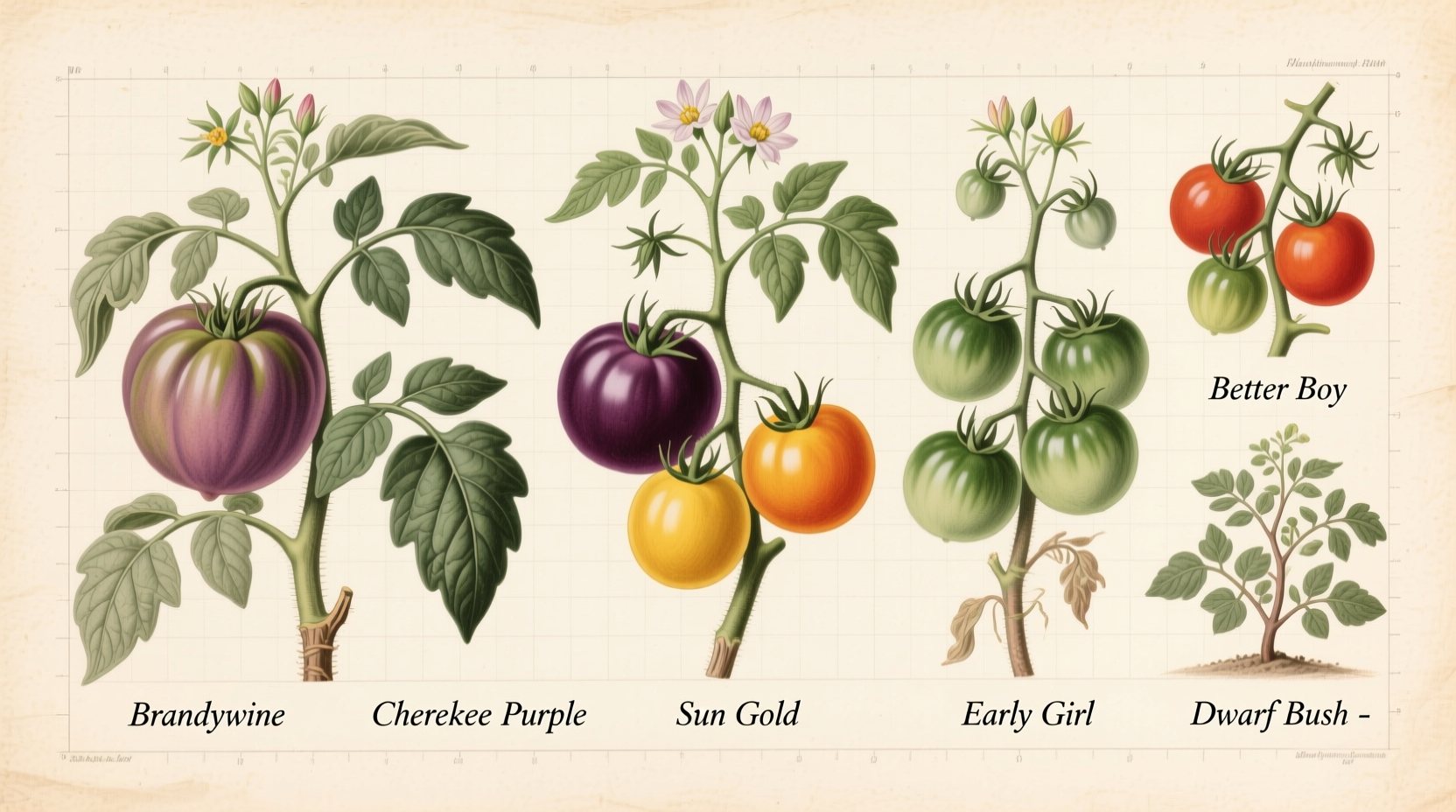Discover which tomato plant types will thrive in your garden space and climate. Whether you're growing in containers on a balcony or managing a backyard plot, understanding these fundamental classifications helps you select varieties that match your space, time commitment, and culinary preferences. This guide cuts through the confusion with practical insights backed by horticultural research.
Understanding Tomato Growth Habits: The Foundation
Before selecting specific varieties, grasp the two fundamental growth patterns that determine how your plants will behave throughout the growing season. This knowledge impacts everything from your support system needs to harvest timing.
| Characteristic | Determinate Tomatoes | Indeterminate Tomatoes |
|---|---|---|
| Growth Pattern | Bush-type, stops growing at 3-4 feet | Vining, continues growing 6-10+ feet |
| Harvest Period | Concentrated 2-3 week window | Continuous production until frost |
| Pruning Needs | Minimal pruning required | Regular pruning essential |
| Support System | Cages or small stakes sufficient | Strong trellis or tall stakes needed |
| Best For | Canning, space-limited gardens | Fresh eating throughout season |
Choosing Between Determinate and Indeterminate Varieties
Consider your gardening goals when selecting between these growth types. Determinate varieties like 'Roma' or 'Bush Early Girl' work well if you need a large harvest for canning within a short timeframe or have limited space. Their compact growth makes them ideal for containers and small gardens.
Indeterminate types such as 'Brandywine' or 'Cherokee Purple' suit gardeners wanting fresh tomatoes throughout summer. These vining plants require more vertical space but reward with extended harvests. Research from Cornell University's Cooperative Extension confirms that indeterminate varieties typically produce 20-30% more total fruit over a season compared to determinate types, though spread across a longer period.

Heirloom vs. Hybrid Tomato Varieties
Understanding the difference between heirloom and hybrid tomatoes helps you select plants matching your gardening philosophy and needs:
- Heirloom tomatoes are open-pollinated varieties passed down through generations (typically 50+ years). They offer exceptional flavor diversity but may have less disease resistance. Examples include 'Black Krim' and 'Green Zebra'.
- Hybrid tomatoes result from controlled cross-pollination of two varieties to combine desirable traits. Labeled as F1 hybrids, they often provide improved disease resistance and uniformity. Popular hybrids include 'Celebrity' and 'Big Boy'.
A 2023 survey by the National Gardening Association revealed that 68% of home gardeners grow at least one heirloom variety for superior flavor, while 82% include hybrids for their reliability in challenging growing conditions. This balanced approach maximizes both taste and productivity.
Specialty Tomato Types for Specific Needs
Within the determinate/indeterminate and heirloom/hybrid frameworks, numerous specialty categories serve particular gardening situations:
Container-Friendly Varieties
For balcony or patio gardening, select compact types specifically bred for containers:
- 'Tiny Tim' (determinate, 6-8" tall)
- 'Patio Princess' (determinate, bred for pots)
- 'Tumbling Tom' (indeterminate, cascading habit)
University of Illinois Extension research shows container varieties produce 40% more fruit in pots than standard varieties when given proper care, making them worth seeking out for space-limited growers.
Climate-Adapted Tomatoes
Match varieties to your regional conditions:
- Cool climates: 'Stupice' (early producer), 'Siberian' (cold-tolerant)
- Hot climates: 'Solar Fire' (heat-set fruit), 'Arkansas Traveler' (humidity-resistant)
- Short seasons: 'Fourth of July' (ultra-early), 'Oregon Spring' (cool-weather producer)
Historical Evolution of Tomato Varieties
Tomato cultivation has evolved significantly since their introduction to Europe from the Andes:
- Pre-1500s: Wild tomato species (Solanum pimpinellifolium) grown in western South America
- 1500s-1800s: Limited European cultivation primarily as ornamental plants
- 1800s: First recorded heirloom varieties like 'Brandywine' developed in North America
- Early 1900s: Commercial breeding begins focusing on uniformity and shipping durability
- 1940s: First hybrid tomatoes introduced, prioritizing disease resistance
- 1970s-Present: Heirloom revival movement emphasizing flavor over shipping qualities
This historical context explains why modern varieties prioritize different characteristics. According to USDA agricultural records, over 10,000 tomato cultivars now exist worldwide, with new varieties developed annually through both traditional breeding and modern techniques.
Practical Selection Guide: Matching Types to Your Garden
Follow this decision framework to select the perfect tomato types for your situation:
- Assess your space: Small gardens or containers need determinate or compact varieties
- Evaluate your climate: Short seasons require early-maturing types; hot climates need heat-tolerant varieties
- Determine your harvest needs: Canning requires determinate varieties; fresh eating benefits from indeterminate
- Consider disease pressure: High disease areas need hybrids with specific resistance markers (look for VFN on seed packets)
- Balance flavor and reliability: Mix heirlooms for taste with hybrids for consistent production
Extension services from land-grant universities consistently report that gardeners achieve the best results by growing 3-5 varieties representing different types. This approach spreads risk and provides continuous harvest while satisfying various culinary needs.
Troubleshooting Common Tomato Type Challenges
Understanding your tomato types helps solve common problems:
- Determinate plants stopping production: Normal behavior - these plants complete their lifecycle after main harvest
- Indeterminate plants getting too large: Regular pruning of suckers maintains manageable size
- Heirlooms cracking after rain: More common in heirlooms due to thinner skins; consistent watering prevents this
- Hybrids not coming true from seed: Expected with F1 hybrids; save seeds only from heirloom varieties
Remember that proper support systems differ significantly between types. A study published in the Journal of Horticultural Science found that indeterminate varieties grown with Florida weave systems produced 25% more marketable fruit than those with standard stakes, while determinate varieties performed equally well with simple cages.











 浙公网安备
33010002000092号
浙公网安备
33010002000092号 浙B2-20120091-4
浙B2-20120091-4